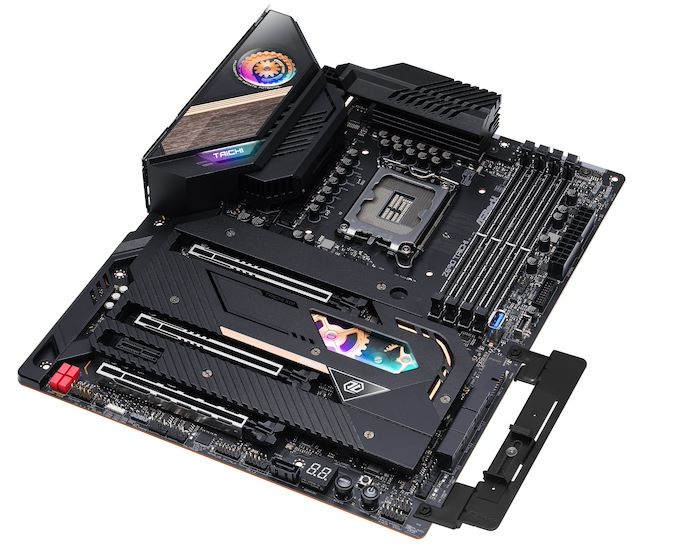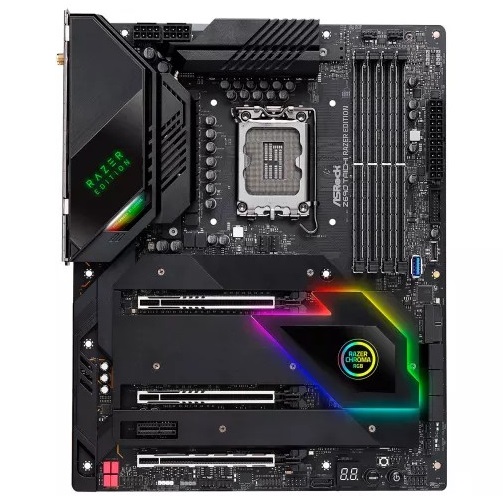The Intel Z690 Motherboard Overview (DDR5): Over 50+ New Models
by Gavin Bonshor on November 9, 2021 9:00 AM ESTASRock Z690 Taichi & Z690 Taichi Razer Edition
Kicking off our Z690 overview in alphabetical order, we'll start with ASRock. ASRock includes its patent-pending ASRock Graphics Card Holder with all of its Z690 models. This is designed to help prevent sagging when used with heavier and long graphics cards.
As it currently stands, the most premium model in ASRock's arsenal for Z690 is from one of its most successful motherboards series, the Taichi. The ASRock Z690 Taichi has a variety of premium features including an advertised 20-phase power delivery with the latest 105 A power stages, as well as a slightly redefined look for 2021. Touching on the design, ASRock includes its mechanical cogwheel effect built into the rear panel cover, which includes RGB LED backlighting, with more RGB built into the cleverly designed cogwheel inspired chipset heatsink.
Looking at the lower portion of the Z690 Taichi, it includes three full-length PCIe slots, including the top two operating at PCIe 5.0 x16 and x8/x8, a third full-length PCIe 4.0 x4 slot, and one PCIe 3.0 x1 slot. Focusing on storage, the ASRock Z690 Taichi includes two PCIe 4.0 x4 M.2 slots, with a third M.2 slot that has support for both PCIe 3.0 x4 and SATA drives. The board also features seven SATA ports in total, with six of these supporting Intel RAID 0, 1, 5, and 10 arrays. Located in the top right-hand corner are four memory slots that can support DDR5-6400, with a combined capacity of up to 128 GB.
The ASRock Z690 Taichi Razer Edition shares the same feature set as the regular Z690 Taichi, but with a Razer-inspired twist. This includes a funky Razer Edition logo on the rear panel cover, with Razer Chroma RGB LED lighting which from the image above, pops really nicely. It drops the cogwheel theme of the Taichi and essentially replaces it with Razer branding.
On the rear panel of the ASRock Z690 Taichi is a pair of Thunderbolt 4 Type-C ports, with two USB 3.2 G2 Type-A, and four USB 3.2 G1 Type-A ports. Onboard audio is handled by a Realtek ALC1220 HD audio codec and ESS Sabre 9218 DAC pairing and consists of five 3.5 mm audio jacks and one S/PDIF optical output. Interestingly, ASRock has put the audio connectors in the middle of the rear panel, as opposed to the end. For networking, ASRock is using a Killer E3100G 2.5 GbE controller, with an additional Intel I219-V Gigabit controller, with a Killer AX1675 Wi-Fi 6E CNVi. Finishing off the rear panel is a single HDMI 2.1 video output and a small BIOS Flashback button.













126 Comments
View All Comments
Dahak - Tuesday, November 9, 2021 - link
Will there be a list of DDR4 only board as well?Ryan Smith - Wednesday, November 10, 2021 - link
Yes, we're also putting together a guide for DDR4 boards.jh20001 - Wednesday, December 1, 2021 - link
Any news on the DDR4 story? Would be nice to know what model is the best for performance/features in the eyes of others.Flunk - Tuesday, November 9, 2021 - link
Intel's actually released a compelling new chipset? I'm surprised to see DDR5 and PCIe 5 support, but USB 4 seems to be notably absent, despite there being no reason at all to omit it. Intel is finally one-upping AMD after a few years of playing #2.Exotica - Tuesday, November 9, 2021 - link
Thunderbolt4 is usb4 capable…CharonPDX - Tuesday, November 9, 2021 - link
Yep, the only thing USB4 adds over "USB 3.2 2x2" is Thunderbolt support. Therefore any Thunderbolt 4 device is automatically USB4. In fact, essentially any board with "Thunderbolt 3" along with USB 3.2 2x2 basically get "USB4" status for free.DigitalFreak - Tuesday, November 9, 2021 - link
USB 3.2 2x2 is 20 Gbps. USB 4 is 40 Gbps.12345 - Wednesday, November 10, 2021 - link
That's why they mentioned TB3. 40Gbps support is also optional for USB4.12345 - Wednesday, November 10, 2021 - link
DP 2.0 is mandatory for USB4 so TB3 support isn't good enough.KarlKastor - Wednesday, November 10, 2021 - link
That is only the name. The question is, with what speed you can run USB devices.